You run into two types of homeowners at your local Home Depot. One is the guy responding to his significant other’s request for a nice garden shed. Find him at the prefab structures aisle comparing costs, pacing off the floor plan, and wondering how he’ll get it all down the driveway. The other guy is wheeling that precarious flat cart around like a contractor on a deadline. He has the bags of cement, a pile of two-by-fours, nails, straps, and roofing supplies. His project will take a few weeks, it’s true, but it’ll be exactly what he wants. Same deal for motorcyclists hankering for a lightweight sporty touring bike. Do you run over to your BMW dealer and plop down for one of the new F 800 GTs, a bike thoroughly developed and fully equipped for this ST application? Or do you come at it from another angle, perhaps with a bike you already own? People will sell you hard luggage and tall windscreens all day long.
That’s the tail and now here’s the dog it’s wagging: We kept the F 800 GT that staffer Zack Courts rode at the BMW press launch and were kicking around ideas for a good comparison. With the demise of Honda’s 800cc VFR and the NT700V and a general dearth of competition in the 800 ST class, we didn’t have any brilliant insights on how to benchmark the reworked GT. BMW went to the trouble of updating the GT’s ergonomics and aerodynamics while it changed the name from F800ST, and there we were, unable to give it context.
Until, that is, our friendly Kawasaki press guy called. “Hey, I have this Versys with a bunch of our accessories installed. Saddlebags, a taller windscreen, really neat stuff. Would you like to try it?” An idea crawled from the primordial ooze and became a concept: Start with the Versys, a terrific all-around motorcycle—so good we named it Motorcycle of the Year in 2008—and see if a bunch of credible, touring-oriented updates would make it a viable competitor to the F 800 GT. Or even get it close.
Oh, but surely there's a massive price difference between a 650cc Japanese do-it-all and a Bavarian sport-tourer. And you're right. BMW starts bidding at $11,890, Kawasaki a mere $7,999. Moreover, our BMW tester had the Safety Package (including ESA II electronically adjustable suspension and traction control, called ASC) for $795, as well as the Luxury Package (including heated grips, an onboard trip computer, centerstand, and hard-luggage mounts) for $505. The GT's plastic hard saddlebags, keyed to the ignition, run an additional $868. When you include the $495 destination fee, our Dark Graphite Metallic GT carried a hangtag that said, somewhat breathlessly, $14,553.
Now, the Versys. Start at eight grand for the big piece, a 649cc thrill ride in miniature. And now the farkles. Kawasaki sells a version of Givi's 34-liter saddlebags and mounts through its dealer network—a nice thing for easy availability and convenient when financing the whole shebang. By the time you're done buying everything you need—the cases, mounts, turn signal relocation caps, and color panel set (matched, in our case, to the pristine white Versys)—you're looking at $1,102.80. Plus installation.
The modded Versys also came with the Vario windscreen, which is taller and wider than stock and is fitted with a spoiler/adjustable wind deflector. It runs $199.95. Kawasaki also sent along a handy 8-liter soft top case that cleverly mounts to the passenger portion of the seat so that it can't be removed without first unlocking the seat. It costs a mere $89.95. To be totally fair to the BMW, you would want to add Kawasaki's heated grips ($229.95) and 12-volt socket ($115.90 including the required relay kit), even though these items weren't on our testbike. Bottom line: $9,737.55, plus whatever your Kawasaki dealer wants to charge for installation.
That $4,800 difference reflects a few things, including the BMW's bigger engine, standard ABS (not even available on the Versys, at least not yet), traction control, and ESA suspension adjustment. To be fair, though, BMW's ESA operates only on the shock's rebound circuit, and the distinctions among Sport, Normal, and Comfort are very subtle. Kawasaki's version of suspension adjustment is digital in a different way: Use your fingers to move the rear shock's rebound adjuster. The BMW's front end is not adjustable, where the Versys has variable spring preload and rebound damping. The BMW has a nifty hydraulic preload adjuster for the shock, while the Kawasaki's link-less damper is sufficiently exposed that preload changes are easy, though you will need a tool. Props to Kawasaki for providing the tool with the bike.
The way these two bikes ride provides a glimpse into their personalities and missions. The Kawasaki is what you might call a street-biased ADV machine or a cut-rate Multistrada—long(ish)-travel suspension, lots of ground clearance, curious styling that suggests a post-wedding-reception tryst between a Ninja 1000 and a KLR. Somehow, Kawasaki managed to fit reasonably good suspension components into a budget bike, so the ride motions are more sophisticated than you expect; both ends manage ripples and stutter bumps well enough that the typical LA freeway causes a minor jiggle and not a head-bobbing pitch-fest. Pushing harder through corners gets the Versys moving around noticeably, though some of the effect is certainly amplified by the tall riding position. For our purposes as a lightweight sport-touring machine, the Versys scores well enough that suspension components aren't the first thing you want to upgrade.
BMW's reworked F bike offers a more refined ride overall, but it's not as well balanced. Once you twist the rear preload up to compensate for those packed hard bags (58 liters, total capacity), weight moves forward and the nonadjustable fork seems a little overwhelmed, and there's nothing you can do about it. In fact, the BMW had very good ride motions most of the time but is never quite settled in fast sweepers; we also bottomed the fork heavily a couple of times. Not like the F800 is grossly overweight. At 497 pounds wet (bags in place), the GT is just 15 pounds heavier than the fully equipped Versys.
Touring comfort is as much about ergonomics as it is ride quality, and here the two bikes are quite different. The BMW is nearly perfect, a comfortable, European style of sporty crouch; the new large-diameter handlebar arches slightly forward from the clamps and bends backward at the grips to place your wrists at a natural angle. Compared to the old F800ST, the riding position is roomier and more relaxed. But it's not as relaxed as the Versys'. The Kawasaki's layout feels a bit dirtbike: a tall handlebar slightly close set, with the footpegs feeling a bit further forward and down than you'd expect from a pure streetbike. (Let's face it, the Versys' dirt pretensions are wafer thin.) Both bikes have good saddles; the BMW's fit all of our testers well, but the Kawasaki's cramped the style of our taller riders.
The longer you sit there, the more important weather protection is, and neither bike really nails it. BMW altered the fairing on the F800 in making the GT, and it provides very good upper-body coverage, though some of our riders found that the integrated screen dumped turbulence at chin level, where it makes any helmet seem loud and blustery. Our taller riders could take it in the neck, so to speak. Aerodynamics are the Versys' kryptonite. That tall screen, looking like a plexiglass shovel head, did improve coverage compared to the stock piece, but no amount of fiddling with the spoiler angle or even changing the rake of the whole assembly made our riders happy.
It's fair to say the Kawasaki's conventional 649cc parallel-twin engine—with strongly oversquare bore and stroke dimensions and a 180-degree crank—gets dusted by the BMW's more powerful engine. Judging by dyno figures, the 798cc GT should leave the Versys for dead, considering it packs more peak horsepower (79.8 versus 58.1 bhp) and torque (54.6 versus 42.4 pound-feet). A 149cc advantage will do just that.
But here's the thing: It doesn't feel like it. Thanks to crazy-short gearing and relatively little flywheel effect, the Versys' liquid-cooled engine feels ever eager, ready to zing right to the 10,500-rpm redline, happy to play in the meat of the powerband between 6,000 and 9,500 rpm. By contrast, the F800's engine, featuring BMW's version of a 360-degreee crank using an opposed counterbalancing link to quell vibration, always feels stolid and strong, but rarely does it make you want to wring its neck. Disparate vibration characteristics might be part of this: Kawasaki's mill uses a conventional counterbalancer but still feels a bit gritty and grunty, while what vibes get past BMW's method are much higher frequency. The Beemer feels, at times, a bit strained and sounds like it's revving higher than it is. You can't deny the actual thrust, but the F-GT doesn't seem like it's enjoying the ride as much.
When exercising the sport component of a sport-tourer, these two make surprisingly good dance partners. Even with the saddlebags brimming, the Versys keeps its light-feeling nature, bending into corners with low effort, accurate steering, charging through with far more cornering clearance than you'll ever need and just enough poke that you don't spend too long waiting for the next corner. Its only weakness is braking; the ancient sliding-pin, two-piston affairs up front are totally outgunned by the BMW's ABS-backed Brembos.
Where the Kawi is a nimble, slightly dirtbike-like charger through corners, the BMW reflects its GT moniker with smooth (also light) steering but less willingness to be flicked over at the last second. It wants some warning but will happily fly toward the apex hard on the binders and find a smooth, graceful line out. Where the Versys makes up ground mid-corner, the BMW responds on the brakes and with more grunt on the exit. Equally skilled riders will find it difficult to create a gap until the roads turn really fast and the BMW's power advantage takes hold.
Eventually, the destination appears, and how much you brought with you becomes important. BMW's side-loading bags are just fine, thanks. The right side will hold a full-face helmet (the left has a cutout for the pipe) and both have a helpful fixed floor that keeps your stuff from flopping out as soon as you open the clamshell. Kawasaki's system is a rebadged Givi Monokey V35, a handsome and rugged set of hard cases with 34 liters' capacity each, besting the BMW's by 10 liters—though you won't get a full-face helmet to fit. We love the bags but have issues with the mounts. For some reason, Givi didn't take advantage of the scalloped inner surfaces when designing the mounts, leaving a vast dead space between the bags and the Versys' bodywork. That makes the setup terribly wide. As in 41.4 inches, some 2.4 inches wider than the GT's luggage. Considering that the Versys is already tall and narrow, this setup looks comically broad from behind.
How'd we do? It's actually closer than we thought. There's no question the BMW is a nice piece of work and very well integrated. The way the trip computer, ESA, and the heated grips are clearly part of the machine, not afterthoughts, makes us giddy. And, save for suspension rates that could use a bit of refining, the F 800 GT is really well sorted mechanically. It's undeniably capable and yet still well clear of BMW's own larger STs in terms of cost. It easily beat the Versys on mileage, largely overcoming our objection to it carrying just 4 gallons of fuel (to the Versys' 5). While we might cringe a little at the GT's $14K-plus as-tested price, you can't deny that it's thoroughly enjoyable to live with.
As for the DIY Versys ST (trademark applied for), the addition of touring-rated gear has done little to dim its sunny disposition. The Versys performs better than it should, does more than you expect, and is far more entertaining than anything in its price range should be. It neatly fills the role of unintimidating sport-tourer, capable of putting on the miles with nearly the same comfort of the BMW at a fraction of the asking price. Should Kawasaki ever decide to give the Versys a modern front brake with ABS, we'd jump around like eight-year-olds. What we ultimately discovered is that modding the Versys did nothing to dent its easygoing nature while providing a highly functional traveling companion. Here's to all DIY projects ending so well.
AGE: 50 | HEIGHT: 5'9" | WEIGHT: 195 lbs. | INSEAM: 32 in.
Theoretically, BMW’s F 800 GT should be a bike I get all gooey over. I like to travel and really appreciate motorcycles that do so in comfort and with confidence. Clever and seamless integration of features usually gets me going, too; so the Beemer’s built-in electronic niceties like ABS, traction control, and push-button suspension adjustment should have me all aquiver. Finally, the long list of factory options and accessories on tap for the GT should be just the thing to keep me interested once the newness wears off.
And yet, I find myself relentlessly neutral on the bike—not even remotely negative, don't misunderstand, just meh. I think part of my ennui comes from the GT's engine character. For some reason, it doesn't do it for me. Too grumbly at low rpm and too fizzy as you get closer to the 8,500-rpm redline. No complaints about the power, and I'm doubly impressed that it averaged nearly 50 mpg on a trip to and from Monterey. But I have to wonder what it would feel like with a 180-degree crank.
AGE: 29 | HEIGHT: 6'2" | WEIGHT: 185 lbs. | INSEAM: 34 in.
The elephant in the room here is a green one; Kawasaki’s own Ninja 1000. Just $12,099 with ABS, which means the same splurges on Givi bags and heated grips would still undercut the F 800 GT’s price. The Ninja also makes 120 horsepower and only weighs 6 pounds more than the BMW (before adding luggage).
What doesn’t come through on paper is how unintimidating the two bikes in this test feel. I would happily turn a fledgling rider loose on the F 800 GT or Versys, but not the Ninja 1000.
For me, the Versys and F800 are both capable and fun, but you can’t beat the value or the “sunny disposition” (as Cook put it) of the Versys. I’m just so impressed every time I ride it. I would work on the brakes and seat first, but luckily the base price leaves a lot of cash in your pocket.










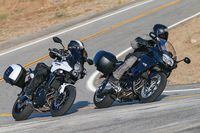


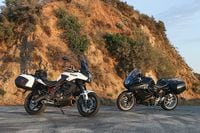
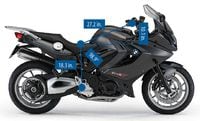

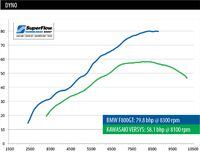

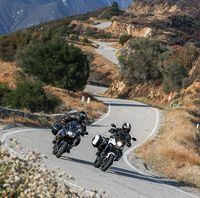

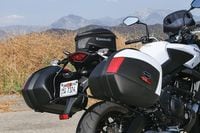


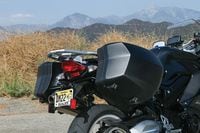
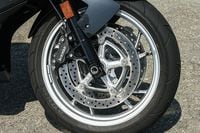


/cloudfront-us-east-1.images.arcpublishing.com/octane/S35YGSEMEZB4BLTDJTSZPF4GLA.jpg)
/cloudfront-us-east-1.images.arcpublishing.com/octane/5UOT6HPX2JFMRJAX6EH45AR4MQ.jpg)
/cloudfront-us-east-1.images.arcpublishing.com/octane/OKWOJWAKP5EP3OACCRRWPCIX2Q.jpg)
/cloudfront-us-east-1.images.arcpublishing.com/octane/2WF3SCE3NFBQXLDNJM7KMXA45E.jpg)
/cloudfront-us-east-1.images.arcpublishing.com/octane/G4MG6OUCJNBSHIS2MVVOTPX65E.jpg)
/cloudfront-us-east-1.images.arcpublishing.com/octane/IIGGWFOTOJGB7DB6DGBXCCMTDY.jpg)
/cloudfront-us-east-1.images.arcpublishing.com/octane/QSTCM6AVEZA5JJBUXNIQ3DSOF4.jpg)
/cloudfront-us-east-1.images.arcpublishing.com/octane/U4I7G625B5DMLF2DVIJDFZVV6M.jpg)
/cloudfront-us-east-1.images.arcpublishing.com/octane/B6XD6LS6IVCQPIU6HXDJSM3FHY.jpg)
/cloudfront-us-east-1.images.arcpublishing.com/octane/ICL63FEDDRDTTMINYICCEYGMDA.jpg)
/cloudfront-us-east-1.images.arcpublishing.com/octane/FCGZHQXRBZFLBAPC5SDIQLVF4I.jpg)
/cloudfront-us-east-1.images.arcpublishing.com/octane/WNOB6LDOIFFHJKPSVIWDYUGOPM.jpg)

/cloudfront-us-east-1.images.arcpublishing.com/octane/X33NU3E525ECRHXLNUJN2FTRKI.jpg)
/cloudfront-us-east-1.images.arcpublishing.com/octane/6KKT5NNL2JAVBOXMZYS5ZO76YA.jpg)
/cloudfront-us-east-1.images.arcpublishing.com/octane/J5RKG5O455GMPGQRF2OG6LRT7A.jpg)
/cloudfront-us-east-1.images.arcpublishing.com/octane/GX2CIZKQVRH2TATDM26KFG2DAE.jpg)
/cloudfront-us-east-1.images.arcpublishing.com/octane/ZWIDYSAKQZHD5BHREMQILXJCGM.jpg)
/cloudfront-us-east-1.images.arcpublishing.com/octane/CYUHJZCTSJCH3MRAQEIKXK7SCQ.jpg)
/cloudfront-us-east-1.images.arcpublishing.com/octane/LKOFINY56FCXJCANJ5M7ZDQUBY.jpg)
/cloudfront-us-east-1.images.arcpublishing.com/octane/4NBPDACMWJH63JQYJVK3QRBDZI.jpg)
/cloudfront-us-east-1.images.arcpublishing.com/octane/KKHQHRR3FJGX7H2IPU6RALMWG4.jpg)

/cloudfront-us-east-1.images.arcpublishing.com/octane/5IOFS5JAE5FOXMNA23ZRAVVYUU.jpg)